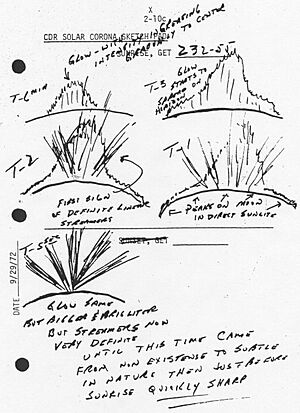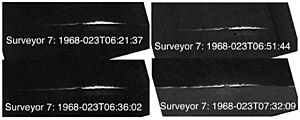Atmosphere of the Moon facts for kids

The atmosphere of the Moon is a super thin layer of gases around our Moon. It's so thin that scientists often call it an "exosphere." Think of it like the very, very edge of Earth's atmosphere, where space begins. For most everyday purposes, the Moon is surrounded by a vacuum, which means there's almost no air at all.
Even though it's incredibly thin, this "lunar atmosphere" is still important for scientists to study. It has some atomic and molecular particles, but it's nothing like the thick air we breathe on Earth, or the atmospheres of planets like Mars or Venus. The pressure of this tiny amount of gas is extremely low, around 3×10−15 atm (0.3 nPa). This pressure changes a bit throughout the lunar day. The total weight of all the gases around the Moon is less than 10 metric tons, which is like the weight of a few cars!
The Moon's atmosphere can't absorb much radiation from the Sun. It also doesn't have layers or circulating winds like Earth's atmosphere. Its gases are constantly escaping into space, so it needs to be refilled all the time.
Contents
Where Does This "Air" Come From?
The Moon's thin atmosphere comes from a few different places.
- One way is called outgassing. This happens when gases like radon and helium are released from inside the Moon's crust and mantle. These gases are created by tiny bits of radioactive decay happening deep inside the Moon.
- Another important source is when tiny space rocks called micrometeorites hit the Moon's surface. Also, particles from the solar wind (which is a stream of charged particles from the Sun) and even sunlight itself can hit the surface. When these things hit, they knock off tiny bits of gas from the Moon's rocks. This process is called sputtering.
Why Doesn't the Moon Have More Air?
The Moon's gravity is much weaker than Earth's. This means it's hard for the Moon to hold onto its gases. Gases can do a few things:
- Some gases can get stuck back into the Moon's soil, called regolith, because of the Moon's gravity.
- But many gases escape the Moon completely. If a gas particle moves fast enough, it can reach the Moon's escape velocity. This speed is about 2.38 km/s (1.48 mi/s), or 5,328 mph (8,575 km/h). If a gas particle goes faster than this, it flies off into space.
- Gases can also be pushed away into space by the Sun's radiation pressure. If the gases become ionized (meaning they get an electric charge), they can be swept away by the solar wind's magnetic field.
What is the Moon's Air Made Of?
The Moon's tiny atmosphere has some very unusual gases. For example, it contains sodium and potassium. You won't find these elements in the air on Earth, Mars, or Venus!
To give you an idea of how thin it is:
- On Earth, at sea level, each cubic centimeter of air has about 1019 molecules.
- By comparison, the lunar atmosphere has fewer than 106 molecules in the same tiny space.
That's a huge difference! In fact, the air on the Moon is so thin that we would call it a very good vacuum here on Earth. It's actually similar to the extreme upper parts of Earth's atmosphere, where the International Space Station flies.
Scientists have used special tools to find out what's in the Moon's atmosphere:
- Sodium and potassium were found using telescopes on Earth that can analyze light (this is called spectroscopy).
- Other gases like argon-40, helium-4, oxygen and/or methane (CH
4), nitrogen (N
2) and/or carbon monoxide (CO), and carbon dioxide (CO
2)) were found by special detectors left on the Moon by the Apollo astronauts.
On average, during the Moon's daytime, here are some of the elements found, in how many atoms per cubic centimeter:
- Argon: 20,000 to 100,000
- Helium: 5,000 to 30,000
- Neon: up to 20,000
- Sodium: 70
- Potassium: 17
- Hydrogen: fewer than 17
Adding these up, there are about 80,000 total atoms in a cubic centimeter. While this is more than the solar wind, which usually has only a few protons per cubic centimeter, it is still almost a perfect vacuum compared to Earth's atmosphere.
The Moon might also have a very faint "atmosphere" of dust particles. These tiny dust bits can float above the surface because of static electricity. This process is called electrostatic levitation. See Lunar soil for more details.
The Moon's Ancient Air
In October 2017, NASA scientists made an exciting discovery! They studied samples of Moon rocks that were brought back by the Apollo missions. These studies showed that the Moon once had a much thicker atmosphere.
This ancient atmosphere existed for about 70 million years, between 3 and 4 billion years ago. It was created by gases that burst out from volcanic eruptions on the Moon. At its thickest, this old lunar atmosphere was even twice as thick as the atmosphere of present-day Mars!
Some scientists have wondered if this ancient atmosphere could have supported life, but so far, no evidence of life has ever been found on the Moon. Eventually, this ancient lunar atmosphere was slowly pushed away by the solar wind and simply drifted off into space.
See also
- Atmosphere of Mercury
- Exosphere
- Lunar Atmosphere and Dust Environment Explorer (LADEE)
- Orders of magnitude (pressure)
- Sodium tail of the Moon


